3.456 miles across Mauritania
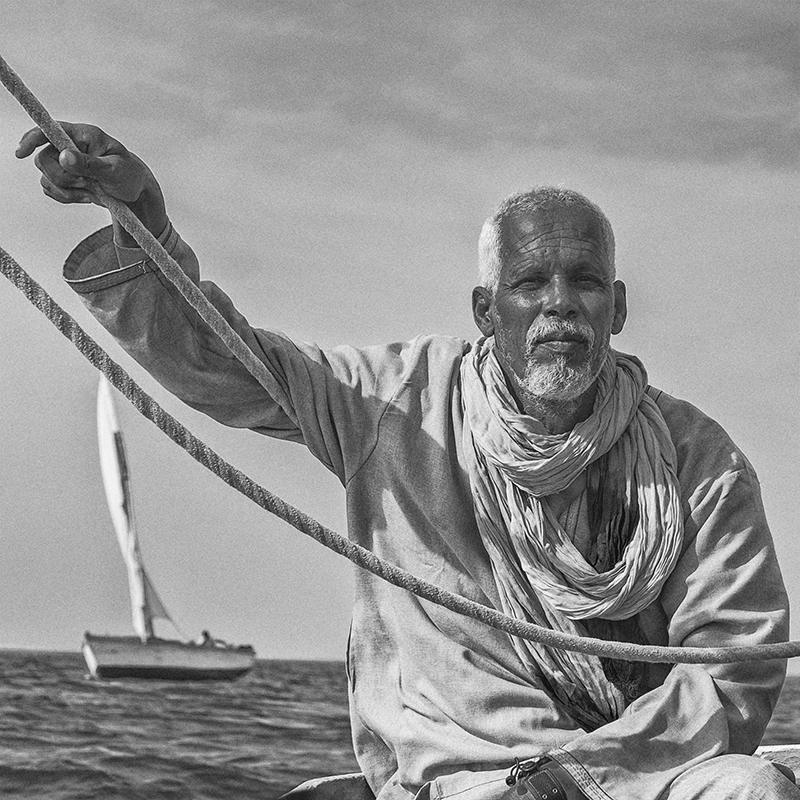
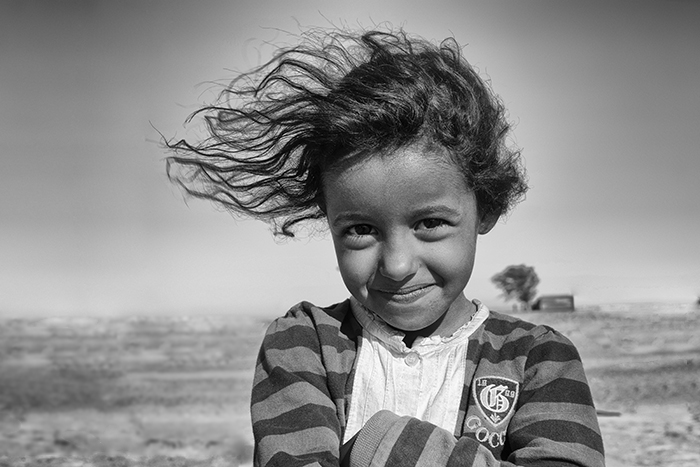
Flower of desert
We come to mind, with our money, our values and a less of time. We want pictures that serve our stereotypes. Images of a peaceful and healing world where Muslims and Christians are friends. People who accept their differences and learn from each other. But we know that reality is different.
The Foreign Office writes: „We are warned against traveling to the border area with Algeria and Mali. It is strongly discouraged from traveling to remote or inadequate effective police or military presence in the Sahara, its peripheral areas and the Sahel. Travel to the north of Mauritania, entry and exit attempts to and from Algeria, Mali and overland to Western Sahara are strongly discouraged. No consular assistance can be provided in Western Sahara. “
We passed through some of these areas and spent most of their time in „remote or inadequate police or military-backed areas of the Sahara.“ Everyone on this trip felt absolutely safe at all times.
In Mauritania, we entered uncharted territory. A tour like this did not exist yet. It was a photo-journey in which we tried to depict the natural beauties of Mauritania, the people and their lives as well as the path of the iron ore from the mines of Zouérate to the port of Nouahibou. The distances are huge and in some places we had less time than I thought necessary. Breakneck rallies across the plains of the Sahara interrupted by turbotography were the result of a tight schedule. But at the end of the journey, which was anything but a vacation, one can sum up: Everything we wanted to arrange worked out! First and foremost, we have to mention our local partner and his team. The owner has reliable contacts in all authorities and companies. His team filled us with every shower and did not even shrink 16 hours ago. So one can only hope that everyone will take home their own positive experiences from Mauritania and spread them there. What we have seen on this trip, however, is only a small part of what this country has to offer.
Arrival
November 5th -At the airport of Nouahibou we are warmly welcomed by our local partner. It will show daily that he is the problem solver even for the most difficult situations. Basically everything we want to do here is illegal and as an individual traveler you would get caught up in the pitfalls of abstruse and opaque laws and regulations in a short time. It starts immediately with smuggling the drone and taking pictures on the airport grounds. But our partner is a networker and knows everyone here. Nobody wants to mess with him. At the booth which represents the imigration counter, we still have to queue. After a short time, there are no more visa stickers available. On such a „tourist rush“ one is not prepared here. In addition to our 15-member group, 12 more tourists have arrived today. In addition, business travelers from different countries join. Normally, those of us who have not gotten visas into the passport would have to come back tomorrow, but Mohamad does it differently. The entire procedure takes one and a half hours until we can check in to the hotel.
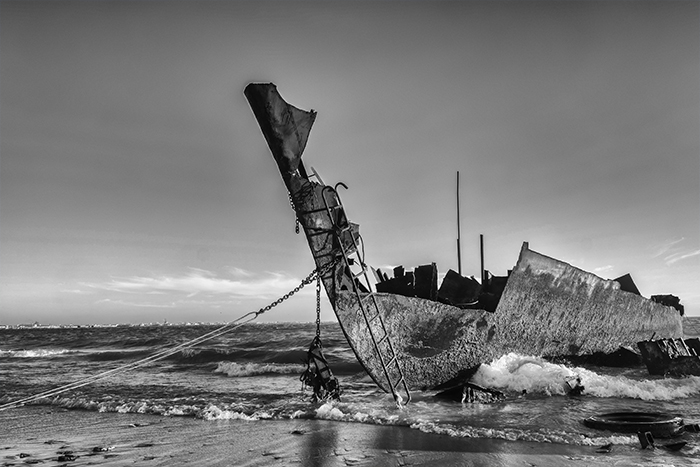
Wrecks and garbage
November 6th – Shortly before sunrise we arrive at the ship graveyard near Nouadhibou. Here we can see where our garbage has remained. Hundreds of still-bottled beer cans, flotsam, fishing nets, tons of dead fish and dead seabirds against the background of rusting shipwrecks make the walk on the beach a very special experience. A French company should scrap the ships. However, ship owners’ protests and the fact that people had set up their own homes on ships prevented this. In August 2006, the EU then decided to allocate € 26 million to clean up the wrecks to improve navigability and safety in Nouadhibou Bay, thus boosting port activity. Twelve years after the end of the project, only a few shipwrecks remain. The big freighters lying on the sand on the beach were the first to disappear. After breakfast, there is still time for a trip to the fishing port. Here boats of all sizes are lined up in hundreds. Most of the smaller fishing boats are still made of wood but with a layer of polyester provided to make them supposedly longer lasting. Off to the desert During the first hour’s drive we pass four checkpoints where we have to stop. The wind shakes the small palm trees, in whose shade we hold for the lunch break. Our chef conjures up a delicious treat with bananas, salads, tuna and bread. While we eat in sight of the railway line, with a deep drone, the water train passes by the oasis. A little later, an ore train with 97 cars comes from the iron mine at Zouérate. Then we drive through the increasingly barren landscape to the south. Wild camels pluck at small trees that bend almost horizontally in the wind. We leave the road and set up camp in a depression in the desert. Nothing has remained of the short refreshment at the station on leaked tank cars with drinking water. Sweaty, we stand in the wind, who whips mercilessly over the dunes and carries trillions of grains of sand that poke on the skin like pinpricks. With great difficulty we set up our tents and are sandblasted, while the setting sun colors the sky yellow like the desert sand. Under an overwhelming starry sky on a cloudless New Moon night, we can see the Milky Way with the naked eye. Escaping the noise of the cities, we have rested in our tents at night. The breakfast was far better than we would have expected here in the desert. The motorized caravan breaks open, further inland. Pale ocher pastel shades interrupted by reddish brown dried tufts of grass fly along the route as they drive. Here and there a group of camels looks for sparse greenery. While the endless landscape, separated only by a flickering dash in the sky and earth, sounds sonorous folklore from the car radio. Everything looks totally surreal. From time to time collections of mud huts with the center of a small mosque appear. Again and again we ask ourselves why and what people live from here? In these settlements live the railway workers, who regularly clear the route from the sand. In one of these settlements we take a break in a shelter of rusty railway sleepers. The journey continues through the desert, roads or paths have not existed for a long time. Only now and then do you hear evidence of a car driving to Sand Valley.
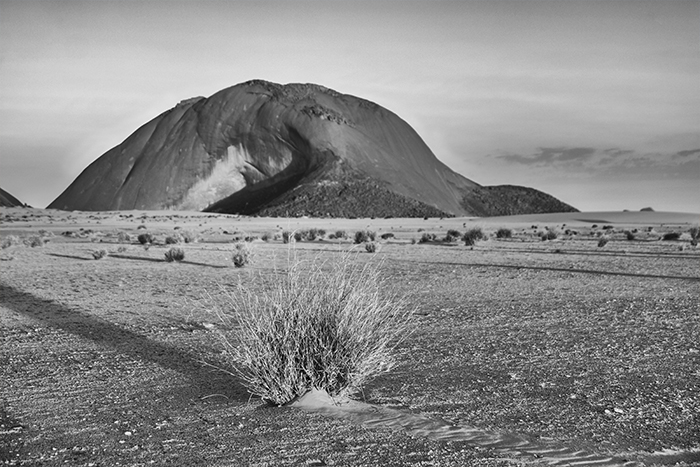
Ben Amira – Mauritania’s Uluru
Ben Amira and Aicha
Once upon a time long ago, Ben Amira married his lover Aicha and they had two sons. Together they lived happily on a farm in the then fertile landscape. But one day a big drought broke over the land. Ben Amira and his two sons had to move to the south for a long time to earn a living for the family. So it was many years before he could finally make his long journey home. When he got there, he realized that Aicha had a lover. Ben Amira was upset and battled with the rival. They fought so hard that Ben Amira hurled his adversary with his head for many miles. The striking bump on the head testifies to this fight. Ben Amira moved with his sons to a distance from Aicha, which symbolizes the separation.
It is the geology that seeks to disenchune this place, because it is two magma bubbles whose volcanic cones have been eroded by wind and weather over the millennia. A magical aura still surrounds this remote unique place. A few years ago, an international group of artists created petroglyphs, sculptures and works of art at the foot of Aicha.
In a dune between the former lovers among the billions of stars of our Milky Way we build our tent camp. While we savor sundowner tea, a storm rises from the desert that will not let us sleep all night. He distributes the fine sand of the Sahara into the last crevice of man and technology.
November 8th – The caravan is chasing through the sand. Depressed looking wild donkeys take flight and camels look after us indifferently, while the dust trail merges with the sky and landscape. From the car radio sounds the wailing voice of a woman singing songs whose contents we do not understand. The caravan overcomes a mountain range on the Amoghar Pass and reaches Atar behind.
Ataris probably what people from our world call chaotic. While two scrap-ripe Mercedes cars jostle around the roundabout, two donkeys run in the opposite direction and honk their horns. At the street corner fruit and bread from wheelbarrows is sold. There are cafés in the streets, shops that sometimes seem like storerooms and workshops. Flying dealers are trying to sell the few tourists who pass through carvings here. Behind Atar we wind up on an adventurous gravel road on the Adrar plateau. Once at the top, the fourth checkpoint of the day awaits us. Half an hour later we reach the millennial town of Chinguetti.
It is believed that Chinguetti was founded by Berbers in the 11th century. In the 12th century, the city was developed into a fortified center of trans-Saharan trade. The fortress walls have long disappeared, but many buildings date back to this time. The city’s sober, unfussy architecture reflects the Almoravid’s strict, Malikite Islam. Traded once was, among other things, with the salt obtained nearby.
Chinguetti has long been an important station for pilgrims to Mecca and a center of Islamic, religious and scientific teachings. In addition to religious education, the schools taught rhetoric, law, astronomy, mathematics and medicine. Chinguetti has a great importance as a holy city of Islam.
In the 1950s, many people from Chinguetti emigrated to the mining region of Zouérat-F’dérik. The depopulation of the city accelerated through the Western Sahara conflict in the 1970s. Beginning in 1980, people began to think about the historical significance of the city and started with their first restoration work. The city has one of the most important medieval manuscript libraries in West Africa. Here a family has been collecting ancient writings for 300 years. The oldest book here is supposed to be 1400 years old.
Near Chinguetti starts the desert region Erg Ouarane. Here you will find the most impressive dunes of Mauritania, which are still accessible by vehicle. The sand dunes extend endlessly into Mali. In the late afternoon, we meet in the rolling hills of yellow sand on a camel caravan, which pulls towards Chinguetti. (Distance 300 kilometers)
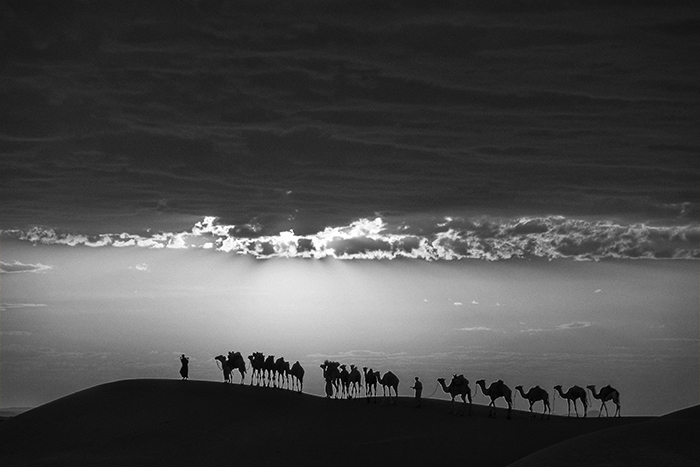
Camel caravan in Erg Ouarane
Erg Ouarne
November 9th – Covered sky instead of sunrise. Pancakes with Schoklala (Arabic for nut nougat cream) instead of omelette. Farewell to the sand sea. Through the gigantic rock massifs of the Tznet Mountains, we continue to the picturesque oasis Terjit. On the edge of the Adrar Plateau, embedded in a deep valley, with towering cliffs, there are waterholes in the shade of many palms, fed by a river from the mountains. In its 600-year history, it was the scene of religious ceremonies, weddings, and the coronation of some African princes. The European adventurer Michael Johnson was the first foreigner to enter the oasis. The easy accessibility, 45 kilometers south of Atar and the film-suitable scenery are reason for that this oasis can be found on almost every itinerary of the few tourists in Mauritania. Thus, foreign visitors are now required a modest fee. As we listen to the birds singing and the babble of the river, we relax and have lunch.
A gravel road of fist-sized stones branches off the main roads and leads down into a deep-cut canyon, at the end of which the valley opens wide. In the unique Vallée Blanche, bright sand dunes tower over a hundred meters up almost to the mountain peaks. A special feature are the numerous trees that grow here from the dunes. The „Passe de Tifoujar“ and especially the ride on the steep sandy track up to the rocky plateau is a real off-road adventure. We set up our camp at the bottom of the Vallée Blanche, put up our fabric houses and sit around the campfire for a long time. (Distance 250 kilometers)
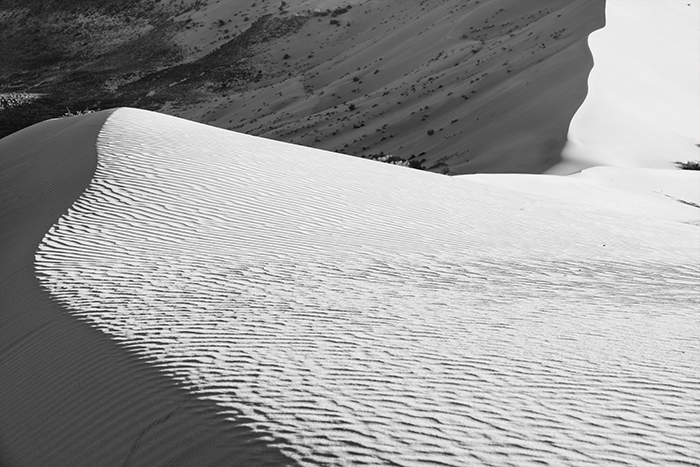
Dune in the Valleè Blanche
Road Run
November 9th – The sun strokes the stone heads of the surrounding rocks. The sand dunes shine golden, at the end of which green trees line the valley. Of the nocturnal beetles, lizards and hares are only the traces to be seen, which are drawn like artistic reliefs in the sand. Unfortunately, this is the moment when we say goodbye to the quiet beauty of the Vallée Blanche. On the way out of the valley we meet a camel herder from the tribe of semi-nomadic Khaïmas who live in this region.
The road network of Mauritania is about 8,100 kilometers long and only about 1,700 kilometers are currently paved. Our route takes us out of the mountains on the RN1 road. This section is paved, but an accidental semi-trailer just outside the city Ain disgust Taya shows how dangerous these pass roads can be anyway. The rock massifs behind us are getting paler, while the landscape slowly changes back to the desert. Suddenly the asphalt band ends again and we strive for endless sand fields towards the coast.
Shante Chueguetti sings with a fragile voice of love and sorrow as the endless desert passes by the window for hours.
Through the town of Akjoujt we drive to the oasis Beni Chab, where we make our lunch break.
How long the oasis can withstand the desert sand, you do not know. Many houses would have been swallowed up by the desert if they were not constantly freed. We set up our tables and chairs in a shabby, greasy corner under a tree. Dust and sweat has become normal for us now, and so does not bother us any soft donkey droppings between the toes in the sandals.
A little later, the pick-ups, a train of dust pulling away, continue their journey through the desert. We drive towards the National Park Banc d’Arguin. In each direction to the horizon only sandy plain, in the dried-thorn-proven bushes waiting for the next rain, which may come only in five years. The horizon, as drawn by the ruler, is occasionally interrupted by a sand dune. Even rarer are human settlements here in this wasteland.
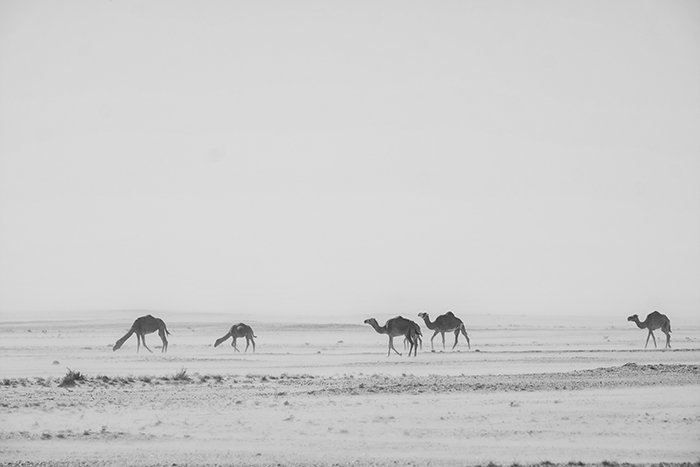
Wild camels in sandstorm
All cities and villages in Mauritania offer the same post-apocalyptic image. First of all, you pass the belt of garbage, plastic bottles, cans, oil containers and car wrecks. In the center of town you are then in the middle of a large trash can. Only here is everything that you have transported on the street flattened. The people here have other concerns than to train environmental awareness. Any packaging that has been consumed is immediately transported by gravity on the sandy soil. Probably no one would be angry if you came here and just dump a ton of garbage on the roadside downtown.
Without any kind of transition the desert reaches to the sea. As if the whole Sahara was just a huge beach. The sand track has now turned into a narrow asphalt band that has to be freed from the sand again and again with a lot of effort. Here, near the coast, there are again small accumulations of corrugated iron, wood or stone huts. In two of these small places are warehouses and walled industrial complexes that do not reveal what their purpose is. In these places, the main street is even lined with a solar-powered street lighting, which does not work. Ten and a half hours we need from the Vallée Blanche to the camp of the fishing village Iwik. There are even small huts to stay here, washing facilities, Toilets and two larger buildings in the kitchen and dining room are available. (Distance 630 kilometers)
National Park Banc d’Arguin
The Banc d’Arguin National Park was established in 1976 as a nature reserve for the protection and conservation of these ecosystems, natural resources and valuable fisheries. With 12,000 square kilometers, it is one of the largest national parks in the world. In 1989, Banc d’Arguin National Park received the status of a UNESCO World Heritage Site. Several NGOs are involved to support the park in its mission of ensuring harmony between the local community and conservation. The biggest challenge is effective monitoring and management in such a large area. The park occupies two-thirds of the northern half of the Mauritanian coast and the protected area covers more than just the coast. In the bay there are sand dunes, coastal marshes, tidal flats and small Islands.
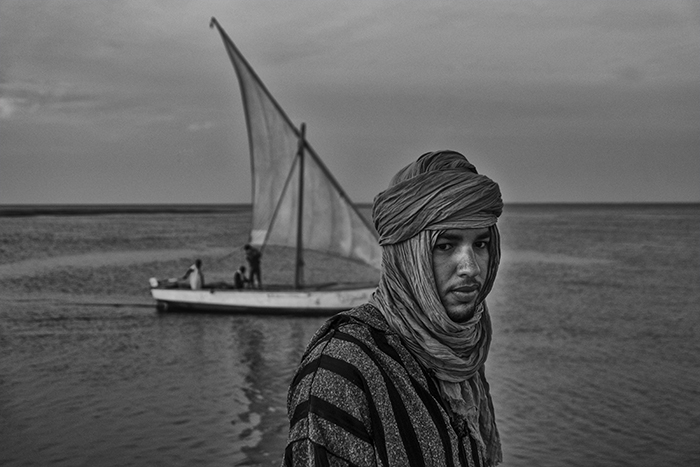
Imrague fisher men
But here, too, overfishing threatens to throw this ecosystem off balance, and the Mauritanian officials are doing their best to control access. The United Nations Environment Program states that park guards are patrolling the area and that access to the National Park is controlled to prevent illegal fishing and disturbance of waterfowl. The guards stationed in Iwik and the sub base in Oued Chibka conduct sea patrols and control access to the islands. An eight-headed camel patrol tries to restrict the hunt.
The Imrague ethnic group, estimated at 800-1,500 members, traditionally live in the Banc d’Arguin reserve. They are known for symbiotic fishing with dolphins, a technique that has been passed down from generation to generation. Dolphins drive small swarms of fish into the nets of the fishermen. However, only if there are enough fish and that happens more and more rarely. For reasons of nature conservation, they were not allowed to motorize their boats until today, so they operate the fishing as once with sailing boats and small nets. But fish trawlers from Europe, Japan, China, Ukraine, Russia and other countries drive to the borders of the national park, half of which covers the sea. The crews of the fish trawlers do not give a damn about quotas and conservation. As they have fished their own fishing grounds, they now deviate to coastal, whose coastal protection can be described as rather deficient. This in turn robs the fishermen of Mauritania and other African states of their livelihoods. Europe pays $ 86 million a year to Mauritania. The money is partly spent on coastal protection. However, 90 percent of this sum disappears without the Mauritanian government being able to provide information on the whereabouts.
The Frenchman Luis Leduget has turned his back on Europe and has been living in Mauritania for decades. He says, „The state of the sea? A disaster! From the perspective of my field of expertise a disaster. The sea is overfished, the ecosystems are out of balance. Behind this is a strong economic lobby. On the other hand one does not arrive. No one is looking for solutions – to the bitter end. “

Iwik
A small group of modest buildings running through their alley goats, forms the core of the village Iwik. The beach is a colorful collage of fishing nets, wooden boats, shells and garbage. Behind it, the waves of the sea glitter through the triangular sails of the boats in the sun. Directly on the beach there is also a boat under construction on the keel. In 1976 the boats were counted. There were 114 and more, according to the conditions imposed by UNESCO, even today. The world of the Imraguene revolves around the sea and its cultural traditions are different from that of the majority of Mauritanians. The politicians would like to see Imrague fully integrated and restrict the possibility of their fishing.
November 10th – At sunrise we arrive at the port of Iwik. Next to Noumghar, this is the only place where you can see the traditional sailboats and the traditional way of catching fish. Here we rent a sailboat to take photos of the sailing fishermen at work. In the shallow water, where the fishermen can stand, the nets are deployed. Since the dolphin fishery has come to a standstill, the fish are driven by blows with wooden battens on the water surface in the nets. But even this type of fishing records less and less income.
On the Cairo-Dakar Highway we drive in the afternoon towards Nouahibou, but make a stop at the gold mine in Chami. Here is a kilo of gold won daily, but the place and the mine terrain sing completely uninteresting and on top of that even guarded by uniformed. When I stand with my camera on the main street, comes a security guard and asks me for my „permission“. I delegate the problem to Mohamad and never stop talking about it. At 6:30 pm we will be back at the Hotel El Medina. In the evening we go to an expensive restaurant. Although reserved and reserved, it took forever for the food to arrive. The meat was as tough as leather, cold and the rice and potatoes could no longer save it. (Driving distance 180 kilometers)
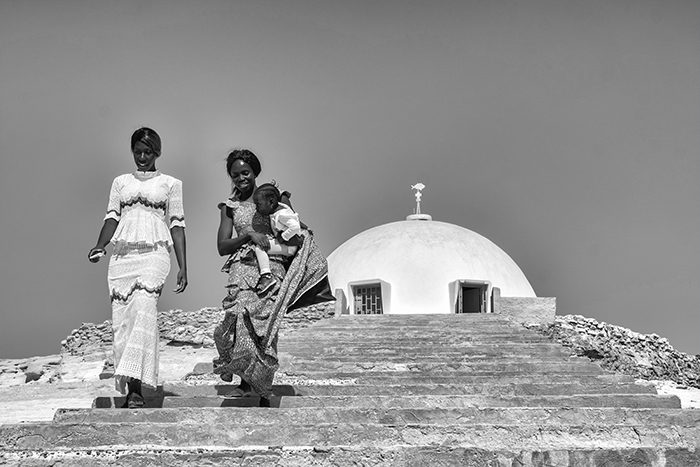
One of two Christian churches in Mauritania – Church of „Holy Fish“
Hang out in Nouahibou
November 11th – Nouahibou is the second largest city and with the largest port the economic center of Mauritania. The location on a peninsula on the West African Atlantic coast was ideal for the construction of an industrial port in the early 1960s, over which the iron ore transported by rail from the mining area around Zouérate has since been shipped. Another industry is fishing. The urban area stretches for about 15 kilometers along the coast from its northern end to the southern district of Cansado. Another three kilometers to the south is the Port of Minerralier iron ore port, from where the Zouérat railway line ends.
On the eastern main street, there are a number of mid-range hotels for business people, as well as restaurants serving European and Asian cuisine.
On the east side of the harbor basin, behind a fishmeal processing plant, follows a long stretch of coastline where shipwrecks have been rustling since the 1980s. Most of the still buoyant ships are anchored in the middle of the Cansado Bay. The European Union has been funding a project since 2013 to remove the wrecks. So it gets less and less from month to month.
Since 2000, Nouadhibou has become a transit point for African refugees seeking to make life-threatening voyages to the Canary Islands in overcrowded and mostly off-shore boats. The Mauritanian government, in cooperation with the EU, built special camps to receive the refugees before being sent back to their home countries. Some still settle permanently. After the security installations of the Spanish enclaves of Ceuta and Melilla were strengthened in 2005, more refugees are switching to replacement routes such as the Nouadhibou. In February 2007, for example, a Spanish rescue ship brought a trawler in distress, with 369 refugees from several African and Asian countries, on the way to the Canary Islands, to the port of Nouadhibou.
Honestly, there’s nothing in Nouadhibou that really interests us. Nouadhibou is just as post-apocalyptic as all cities in Mauritania.
Nouadhibou was the base camp for the tours to the west and inland for us. So it was here two days as relaxed as rarely on our trips to. We make a trip to the lighthouse on Cap Blanc at Nouadhibou and look at the church to the „Heligen fish“, one of the only two Christian churches in Mauritania. Architecturally, it is well camouflaged with its round dome shape in a Muslim country.
For lunch we go to the restaurant „Tako“. The owner is a spirited Spaniard who runs the restaurant along with a group of Han Chinese. „Tako“ is one of the few places where there is beer, schnapps and certainly everything else that is otherwise impossible to obtain. The soft drinks are included in (sometimes) the meals, only the alcoholics are to be paid. A meal here costs about 24 euros and a 0.33 liter can of beer beats with six euros into the office.
In the afternoon we want to visit the fish market of Nouahibou. The afternoon should be the best time to observe the busy activities on the premises. However, we are denied permission to do so. We also fly up at the fishing port and are chased away by the police. Since we have already caused so much attention, the launch of the drone is not possible. Since no train leaves Nouahibou today and the sun is approaching the horizon, there is no option except dinner in a local restaurant. (Driving distance 50 kilometers)
Culinary
We had cereal bar, crispbread, 1 kilogram trail mix, nut nougat cream, candies, heat resistant chocolate, drinking chocolate, teabags and coffee in the luggage. We assumed that the meals were not sumptuous and that most of us did not like it. No problem, so you can get rid of a few pounds. A mistake! Mauritania has everything from delicious fresh white bread, to pizza, burgers and steaks, to ice cream and chocolate. One of the differences: If you order here in the restaurant „Meat“ it is always camel meat. Beef is rare and expensive. With a coastline of 755 kilometers, it is not surprising that many fish dominate the menu. The fruits and vegetables are quite good given the fact that the agricultural area of Mauritania is manageable.

Sahara Express „Société Anonyme des Mines de Fer de la Mauritaire“
November 12th – Mercilessly the sun burns down on the hot desert sand. Lizards and beetles have long been safe from the heat. From the flickering air two bright lights appear and a little later a deep hum swells until all the air seems to vibrate. They are the engines of two locomotives, which pulls a seemingly unending queue of cars behind them. The train has 220 cars and is pushed by two more locomotives. The name Sahara Express is a bit misleading, because the train is neither fast nor is it intended for people.
The country’s only railway line runs from the mine at F’dérik in the north of the country across the Sahara to the port of Nouadhibou. The trains here are among the longest and heaviest in the world. More than 200 wagons are pulled by up to four locomotives. The cargo: up to 21,000 tons of iron ore. The biggest enemy of the railway line is the sand. Every hundred kilometers a deserter squad is stationed whose job it is to clear the tracks filled with sand again. The sand is so aggressive that the tracks and also the wear parts of the train have only one-sixth of the normal lifetime.
This is the first time foreign tourists are allowed to visit the railroad repair shop and the port terminal where the iron ore will be loaded. There is nothing to hide, because the processes and structures, as well as the order are comparable to works in Europe. The merits, depending on the qualifications between 1000 and 1500 dollars. Overall, the visit was quite interesting even if not allowed to be photographed.
The strong wind at the port terminal has bombarded us so with the finest iron ore particles that a stay there was a pretty dirty thing. Back at the hotel I could not resist the urge to have a shower. Just this strong wind prevented my long planned recording of the fishing port with the drone. The only progressed meter by meter and I did not reach the desired position. I still had to pay the 50 Euro baksheesh for the police. Then it goes out of the city to the station, which marks the kilometer zero.
About a hundred people wait there for the train, at the end of a passenger car is carried. Children and adults are pulled through the windows into the car, as not all doors are in the condition that they could still open. Sacks, crates, metal plates, donkeys and goats are loaded into the wagons by pick-ups, and the empty ore wagons are also used for travel. In this car, some of the passengers drive for seventeen hours to Zouérate in the heat of the day, in the cold of the night, by sandstorms and always in the wind-blown ore dust. We follow the train in our comfortable off-roaders and photograph it again at kilometer 35. A little later, as the sun approaches the horizon, the supply train with tank cars for diesel and water comes from the opposite direction.
Direction Zouérate
November 13th With the rising sun, the wind is also stronger again. We take the first train from Zouérate at kilometer 35, at the exit of an S-bend. The train has 97 cars at the top of which the locomotives CC 101 and CC 109 strive. When we take the second train with 195 cars at kilometer 128, with the locomotives CC 127 and CC 122, you can already speak of a sandstorm. With an extreme dust trail, the two-kilometer train passes us by. In view distance followed BB 206 with flat car and a tank car. Near a gold digger tent at kilometer 209, shortly before noon, CC 114 and CC 115 pass by with an empty train of 114 cars. BB 208 we meet with a maintenance train in the oasis Tmeymichat at kilometer 319. At kilometer 321 we have our lunch break.
Within sight of Ben Amira we set up our camp for the night. Soup and pasta salad with beetroot have already been eaten by most people. Again, the wind is refreshing and in the night, which is unusually cold, he shakes unremittingly at the tents.
Train Tracking
November 14th – At the night I put my clothes back on and crawl under the blanket like a cocoon. So it is halfway warm but I find sleep only by the hour. Shortly before sunrise one after the other crawls out of his tent and the camp awakens to weary life. Bitter cold and windy is the morning. After a quick breakfast snack, we climb the nameless photo rock and below us, the Sahara spreads in graceful beauty. Grasses and dunes cast long shadows. The soft morning light makes the rocks appear like artistic reliefs and a pair of huge black crows perform elaborate maneuvers in the thermals. But then the news reaches us that the train to Zouérate will not pass the place until eleven o’clock. The light is then already hard and the landscape looks flat in the high sun.
We are now following the train leaving behind Choum Mauritania and crossing the territory of Western Sahara. We also cross the value Sahara on the asphalt road, where there is not even a checkpoint. This is a huge control madness organized at airports and here you could bring a tank army unnoticed across the borders. An inconspicuous checkpoint on the road comes only far in Mauritanian territory. We continue the train and pick it up at a three-lane exit point at kilometer 597. Here we take a break for lunch, but unfortunately decide for the wrong end of the station, so we miss the actual intersection of the locomotives of both trains. The straight asphalt band we follow to F’dérik. There we try to catch feeder trains from the mines to the station F’dérik, but have no luck. The sun disappears behind the iron rocks five minutes before the train passes by. We give up and drive to the hotel in Zouérate.
The Somasert hotel is a unique composition of tiled industrial design, mint oil paint and wine red curtains illuminated by bare fluorescent lights. In the rooms even I, the filthy, have the urge to squeeze me into a full body protection suit. The only ones who feel comfortable here are the cockroach colonies, which have extended their reign to the top second floor. No matter! The Tropical Institute will help. In the hotel we also have our dinner, but spare us the kitchen to visit.
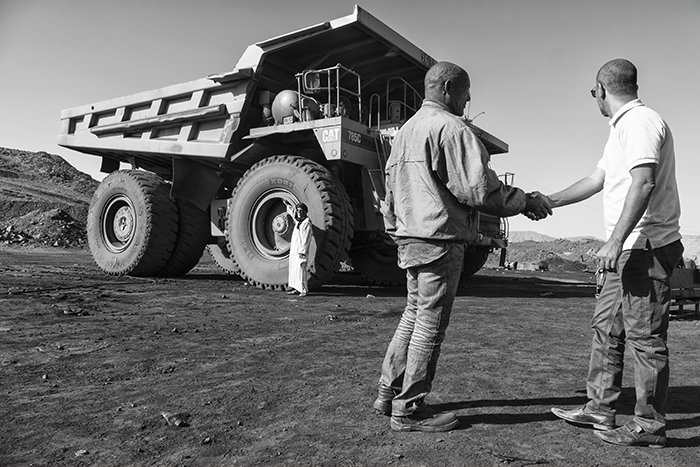
Monsters and men
Iron ore and steel monster
November 15th – Zouérate owes its existence mainly to the iron mine and has the unmistakable charm of a mining town. But unlike what you expect, the city is not covered in plastic rubbish like the rest of the country. Streets and squares look really clean and cars even stop at red traffic lights. The omnipresent garbage is collected in containers and disposed of just outside the city in the area.
Deep holes gape in the mountains around Zouérate. Holes so deep that you can barely see the ground. Dense red dust fills the air here and there. He is whirled up by the huge trucks, which empty as if on an ant road. Slowly and with a deep humming of the 2000 hp engines, they struggle with up to 200 tons of iron ore from the bottom of the open pit. One by one they drive to the crusher. The Crusher is an oversized mortar in which chunks as big as a small car are ground. Via conveyor belts, the milled ore arrives in silos at the loading point, where it is then loaded onto the railway carriages. Mines and loading facilities are in Zouérate, El Rhein and M’Haoudat.
The hotel „Somasert“ is the best hotel in the city and also has the best restaurant, although the staff is a bit overwhelmed with a group of 15 travelers. However, Mohamad wants to introduce us to the local cuisine and escorts us to a small restaurant where the brocade carpet is nailed to the wall and the rubber tiles are laid on the floor. The unanimous opinion; Tasty is different and we would have preferred to stay in the hotel.
November 16th – Honey, butter, the ubiquitous cheese spreads and jam. There are milk from goats, camels or cockroaches – no idea and chemical juices from the tetra pack. You can leave the tea bag in the cup for an hour, the „tea“ still tastes only after lukewarm nothing. The only bright spot is the almost always fresh white bread but we did not come here to eat.
First of all we pay a visit to the French diesel locomotives, which were part of the original equipment of the 1963 railway and are now rotting away from the city. The „guard of the junkyard“ and the one switch, which is here at the branch to serve, is happy about this rare change and invites us to tea. He lives here with three cats in a disused train carriage. A radio device ensures contact with the railway administration and in defense he has an air rifle. He poses with the rifle and we ask him if he has ammo for it. He shows us the „ammunition“ and it is small stones that he collects and that fit into the barrel!
Then finally we manage to order a diesel locomotive to the loading station Rouessa and to prefer the loading there. On a scree with adjoining open-air latrine, we have a lunch break after another two trains have passed this unique photo booth.

Ride the iron snake!
Train Ride
Steel beats go from car to car as the two diesel locomotives CC 123 and CC 1224, each with 4,500 horsepower, begin to pull the two-kilometer-long and 18,000-ton train. Trains are used by travelers to other oases and as far as Nouadhibou. The experience of traveling on the full Erzwagen is certainly not every man’s thing. The endless expanse of the Sahara is enjoyable for a certain time, but mostly the enjoyment turns into boredom after 100 kilometers at the latest. At the latest then the dust has penetrated into the last chink. So we are not unhappy to be able to leave the train after 75 kilometers. Until after sunset we follow the train with the pick-ups and hit the tent in the dunes behind Choum.
November 17th – Glimmering red the rising sun colors the clouds over the desert. One last breakfast in the dunes of the Sahara. Then the Toyota camels are loaded and we follow the route towards Nouadhibou. On the way, we ask a lonely railroad worker for a train at the track. Yes, he had heard a train that had to come soon. Only a little later at kilometer 420 we come to a Leerzug pulled by the two green CC … contrary. At kilometer 368 we pick up a freight train, which is loaded with sleepers and pushed to a construction site. A few kilometers ahead of him, at km 287 is a water supply train on the way. Attached are also some freight cars to supply the settlements along the route. In the settlements of the railway workers large rubber bubbles are embedded in the ground. These are filled if necessary by rail tank cars. A rolling market is under plan on a flatcar at the end of the train. Here, the inhabitants of the settlements can provide goods. In the Oasis of Inal at kilometer 255, the train also stops and while empty tank cars are exhibited, we take a lunch break in the shadow of a water tower. This is also the place of a policeman who is supposed to control passing vehicles. The equipment of the „control point“ consists of a chair. The most urgent task of the sentry is to follow the shadow of the water tower with his chair. In the Oasis of Inal at kilometer 255, the train also stops and while empty tank cars are exhibited, we take a lunch break in the shadow of a water tower. This is also the place of a policeman who is supposed to control passing vehicles. The equipment of the „control point“ consists of a chair. The most urgent task of the sentry is to follow the shadow of the water tower with his chair. In the Oasis of Inal at kilometer 255, the train also stops and while empty tank cars are exhibited, we take a lunch break in the shadow of a water tower. This is also the place of a policeman who is supposed to control passing vehicles. The equipment of the „control point“ consists of a chair. The most urgent task of the sentry is to follow the shadow of the water tower with his chair.
At speeds of up to 120 kilometers per hour, the pick-ups hunt across the Sahara. Only sand dunes and rocky heights slow down the speed. A race against time. We spent more than an hour in the heat of the desert in the desert waiting for a motive with the water train and then hung an hour for lunch. Now is the time to catch the empty train from Nouadhibou until sunset. We race past beautiful sickle dunes that glow golden in the afternoon sun. Some dune fields seem to extend to the horizon and elsewhere a single dinghy rises from the plain and appears as if painted. A little sadness if you do not know if and when you will see the desert again. Half an hour before sunset we reach the oasis Boilinoir, at kilometer 96. But just today, the train was on time and has already left the oasis and we only see disappearing in a distant dust cloud. A pursuit is not possible in the deep sand of the many dunes and so we drive back to Nouadhibou.
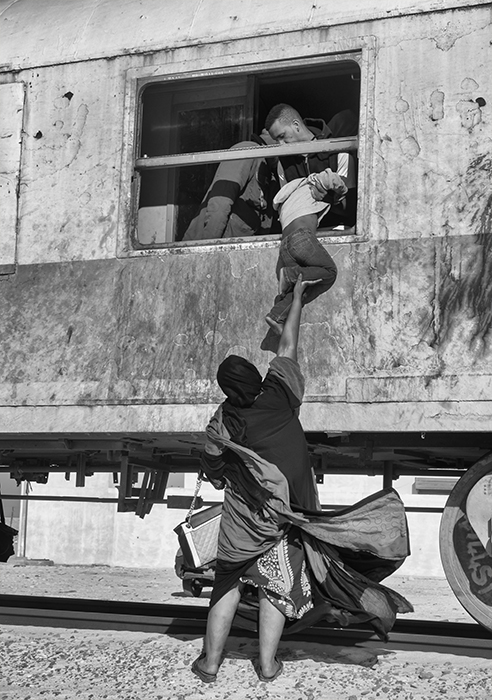
The window is the better door!
Always late – never before
November 18th – Ten to seven, we are back in the pick-up, since from 7:30 clock the train from Zouérate is expected. At kilometer 27, at the post of the gendarmerie, we ask if we are allowed to take pictures there. To our surprise, the request is granted. So we wait for two hours on a weathered coral rock, which will disintegrate in the next 1000 years to the fine-grained desert sand, on the passage of the train to Nouadhibou. Haze envelops the dunes and rocks and the rising sun colors the clouds pink. In the backlight of the rising sun, millions of plastic bottles shine on the nearby beach of the lagoon. Trucks drive into the desert and come back loaded with sand for the construction sites in Nouadhibou. A minibus, on the roof of which goats are stowed under a net, passes the control. It’s hardly boring especially as our drivers set up a table with tea. Mohamad thinks of everything! Then the train comes loaded with iron ore. But also people and goats find space on the full car. At the end, a passenger car, water truck and some freight cars are carried along again. We follow the train to the station where the goats are unloaded in free fall. Then the Mauritania trip was at least photographically run and we drive to the hotel where we have breakfast once again and get ready for departure.
Environment
Reports about garbage rags in the oceans and their consequences for us and the environment are becoming more and more present in our media. But nobody talks about the rubbish carpets in the sand seas. For Mauritanians, the environment is no more than the world around them. As a European, one has the impression that Mauritanians perceive the world around them rather as huge garbage cans. Of course it is understandable to some extent that the people in this country have other problems to solve than to worry about the accumulating garbage. But that also unfortunately affects the wealthy people who earn money with an intact environment.
In the Vallée Blanche, near our camp, a fire burned with a typical black plume of smoke. It was the fire of another group of tourists whose local leaders were burning garbage. Our crew also burned cardboard in the Vallée Blanche that evening and the following morning, cans, scraps of food, plastic and everything else that was needed. Our local guide and owner of a major travel agency in Mauritania, I have addressed and told him that you have to find another solution. It is his land, his nature with which he earns money only when it is intact. He took me fraternally by the hand, affirming how well and important he found my thoughts and answered: „Yes, they are doing it so fast now and tomorrow or during the next tour he would pick up the leftovers and take them to the city. „I have seldom heard such incredible nonsense! Later it was also observed how the garbage at our second camp near Ben Amira was left behind. You do not think about this at all here. The garbage remains in the desert, at some point the wind has blown and away is the dirt. But the dirt is not gone, it is obvious! On roads, in cities, on the coasts in the desert just everywhere. In the whole of Mauritania and in many other African countries. Every year, thousands of tons are added. You do not think about this at all here. The garbage remains in the desert, at some point the wind has blown and away is the dirt. But the dirt is not gone, it is obvious! On roads, in cities, on the coasts in the desert just everywhere. In the whole of Mauritania and in many other African countries. Every year, thousands of tons are added. You do not think about this at all here. The garbage remains in the desert, at some point the wind has blown and away is the dirt. But the dirt is not gone, it is obvious! On roads, in cities, on the coasts in the desert just everywhere. In the whole of Mauritania and in many other African countries. Every year, thousands of tons are added.
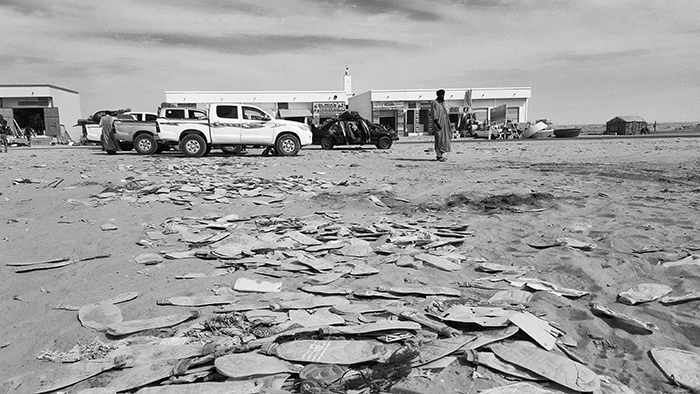
The most common resource in Mauritania …



Schreibe einen Kommentar